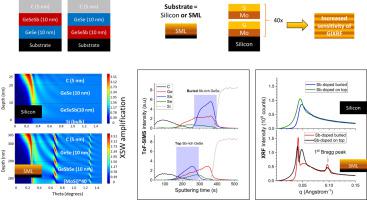当前位置:
X-MOL 学术
›
Spectrochim. Acta B. At. Spectrosc.
›
论文详情
Our official English website, www.x-mol.net, welcomes your feedback! (Note: you will need to create a separate account there.)
Grazing-incidence X-ray fluorescence analysis of thin chalcogenide materials deposited on Bragg mirrors
Spectrochimica Acta Part B: Atomic Spectroscopy ( IF 3.3 ) Pub Date : 2020-06-01 , DOI: 10.1016/j.sab.2020.105864 E. Nolot , W. Pessoa , S. Torrengo , Y. Mazel , M. Bernard , P. Gergaud , Y. Ménesguen , M.C. Lépy , D. Eichert
Spectrochimica Acta Part B: Atomic Spectroscopy ( IF 3.3 ) Pub Date : 2020-06-01 , DOI: 10.1016/j.sab.2020.105864 E. Nolot , W. Pessoa , S. Torrengo , Y. Mazel , M. Bernard , P. Gergaud , Y. Ménesguen , M.C. Lépy , D. Eichert

|
Abstract Advanced chalcogenide materials are key for state-of-the art memories, energy harvesting materials and photonics. The properties of thin chalcogenide layers are highly driven by their chemical composition, chemical depth-profiles and surface/interface effects. The combination of Grazing-Incidence X-ray Fluorescence (GIXRF) and X-ray Reflectometry (XRR) techniques allows for non-destructive access to such information, in the lab or at dedicated beamlines. However, the accuracy of the GIXRF-deduced composition slightly degrades with depth, as the enhancement of the XRF signal by the X-ray Standing Wave (XSW) field is usually limited to the first nanometers at the surface of the probed sample. In this paper, we suggest the use of (Mo/Si)*N Bragg mirrors, rather than bare silicon substrates for thin chalcogenide deposition, to improve the sensitivity of GIXRF/XRR analysis to small process-driven modifications. The aim of such multilayered substrates is to maintain high values of X-ray reflected intensity even at angles significantly higher than the critical angle, therefore generating an XSW-induced enhancement of the XRF signal not only at the surface but also in the depth of the layer of interest. The simulation of GIXRF-XRR data, collected at SOLEIL Metrology beamline and in the lab on Rigaku SmartLab diffractometer, on arsenic-free Ovonic Threshold Switch materials (Ge, Se, Sb) for advanced Phase Change memory (PCRAM) applications illustrates the interest of this approach, which is fully-compatible with numbers of PCRAM materials elaborated with low-temperature physical vapor deposition process.
中文翻译:

沉积在布拉格反射镜上的薄硫属化物材料的掠入射 X 射线荧光分析
摘要 先进的硫属化物材料是最先进的存储器、能量收集材料和光子学的关键。硫属化物薄层的特性在很大程度上受其化学成分、化学深度分布和表面/界面效应的影响。掠入射 X 射线荧光 (GIXRF) 和 X 射线反射计 (XRR) 技术的组合允许在实验室或专用光束线上无损访问此类信息。然而,由于 X 射线驻波 (XSW) 场对 XRF 信号的增强通常仅限于探测样品表面的第一个纳米,因此 GIXRF 推导的成分的准确性会随着深度的增加而略微降低。在本文中,我们建议使用 (Mo/Si)*N 布拉格反射镜,而不是裸硅衬底进行薄硫属化物沉积,提高 GIXRF/XRR 分析对小流程驱动修改的敏感性。这种多层基板的目的是即使在明显高于临界角的角度下也能保持高值的 X 射线反射强度,因此不仅在表面而且在深度产生 XSW 诱导的 XRF 信号增强。兴趣层。在 SOLEIL Metrology 光束线和 Rigaku SmartLab 衍射仪实验室收集的 GIXRF-XRR 数据模拟,用于高级相变存储器 (PCRAM) 应用的无砷 Ovonic 阈值开关材料(Ge、Se、Sb)说明了这种方法与采用低温物理气相沉积工艺制作的大量 PCRAM 材料完全兼容。这种多层基板的目的是即使在明显高于临界角的角度下也能保持高值的 X 射线反射强度,因此不仅在表面而且在深度产生 XSW 诱导的 XRF 信号增强。兴趣层。在 SOLEIL Metrology 光束线和 Rigaku SmartLab 衍射仪实验室收集的 GIXRF-XRR 数据模拟,用于高级相变存储器 (PCRAM) 应用的无砷 Ovonic 阈值开关材料(Ge、Se、Sb)说明了这种方法与采用低温物理气相沉积工艺制作的大量 PCRAM 材料完全兼容。这种多层基板的目的是即使在明显高于临界角的角度下也能保持高值的 X 射线反射强度,因此不仅在表面而且在深度产生 XSW 诱导的 XRF 信号增强。兴趣层。在 SOLEIL Metrology 光束线和 Rigaku SmartLab 衍射仪实验室收集的 GIXRF-XRR 数据模拟,用于高级相变存储器 (PCRAM) 应用的无砷 Ovonic 阈值开关材料(Ge、Se、Sb)说明了这种方法与采用低温物理气相沉积工艺制作的大量 PCRAM 材料完全兼容。因此,不仅在表面而且在感兴趣层的深度产生 XSW 诱导的 XRF 信号增强。在 SOLEIL Metrology 光束线和 Rigaku SmartLab 衍射仪实验室收集的 GIXRF-XRR 数据模拟,用于高级相变存储器 (PCRAM) 应用的无砷 Ovonic 阈值开关材料(Ge、Se、Sb)说明了这种方法与采用低温物理气相沉积工艺制作的大量 PCRAM 材料完全兼容。因此,不仅在表面而且在感兴趣层的深度产生 XSW 诱导的 XRF 信号增强。在 SOLEIL Metrology 光束线和 Rigaku SmartLab 衍射仪实验室收集的 GIXRF-XRR 数据模拟,用于高级相变存储器 (PCRAM) 应用的无砷 Ovonic 阈值开关材料(Ge、Se、Sb)说明了这种方法与采用低温物理气相沉积工艺制作的大量 PCRAM 材料完全兼容。
更新日期:2020-06-01
中文翻译:

沉积在布拉格反射镜上的薄硫属化物材料的掠入射 X 射线荧光分析
摘要 先进的硫属化物材料是最先进的存储器、能量收集材料和光子学的关键。硫属化物薄层的特性在很大程度上受其化学成分、化学深度分布和表面/界面效应的影响。掠入射 X 射线荧光 (GIXRF) 和 X 射线反射计 (XRR) 技术的组合允许在实验室或专用光束线上无损访问此类信息。然而,由于 X 射线驻波 (XSW) 场对 XRF 信号的增强通常仅限于探测样品表面的第一个纳米,因此 GIXRF 推导的成分的准确性会随着深度的增加而略微降低。在本文中,我们建议使用 (Mo/Si)*N 布拉格反射镜,而不是裸硅衬底进行薄硫属化物沉积,提高 GIXRF/XRR 分析对小流程驱动修改的敏感性。这种多层基板的目的是即使在明显高于临界角的角度下也能保持高值的 X 射线反射强度,因此不仅在表面而且在深度产生 XSW 诱导的 XRF 信号增强。兴趣层。在 SOLEIL Metrology 光束线和 Rigaku SmartLab 衍射仪实验室收集的 GIXRF-XRR 数据模拟,用于高级相变存储器 (PCRAM) 应用的无砷 Ovonic 阈值开关材料(Ge、Se、Sb)说明了这种方法与采用低温物理气相沉积工艺制作的大量 PCRAM 材料完全兼容。这种多层基板的目的是即使在明显高于临界角的角度下也能保持高值的 X 射线反射强度,因此不仅在表面而且在深度产生 XSW 诱导的 XRF 信号增强。兴趣层。在 SOLEIL Metrology 光束线和 Rigaku SmartLab 衍射仪实验室收集的 GIXRF-XRR 数据模拟,用于高级相变存储器 (PCRAM) 应用的无砷 Ovonic 阈值开关材料(Ge、Se、Sb)说明了这种方法与采用低温物理气相沉积工艺制作的大量 PCRAM 材料完全兼容。这种多层基板的目的是即使在明显高于临界角的角度下也能保持高值的 X 射线反射强度,因此不仅在表面而且在深度产生 XSW 诱导的 XRF 信号增强。兴趣层。在 SOLEIL Metrology 光束线和 Rigaku SmartLab 衍射仪实验室收集的 GIXRF-XRR 数据模拟,用于高级相变存储器 (PCRAM) 应用的无砷 Ovonic 阈值开关材料(Ge、Se、Sb)说明了这种方法与采用低温物理气相沉积工艺制作的大量 PCRAM 材料完全兼容。因此,不仅在表面而且在感兴趣层的深度产生 XSW 诱导的 XRF 信号增强。在 SOLEIL Metrology 光束线和 Rigaku SmartLab 衍射仪实验室收集的 GIXRF-XRR 数据模拟,用于高级相变存储器 (PCRAM) 应用的无砷 Ovonic 阈值开关材料(Ge、Se、Sb)说明了这种方法与采用低温物理气相沉积工艺制作的大量 PCRAM 材料完全兼容。因此,不仅在表面而且在感兴趣层的深度产生 XSW 诱导的 XRF 信号增强。在 SOLEIL Metrology 光束线和 Rigaku SmartLab 衍射仪实验室收集的 GIXRF-XRR 数据模拟,用于高级相变存储器 (PCRAM) 应用的无砷 Ovonic 阈值开关材料(Ge、Se、Sb)说明了这种方法与采用低温物理气相沉积工艺制作的大量 PCRAM 材料完全兼容。

























 京公网安备 11010802027423号
京公网安备 11010802027423号